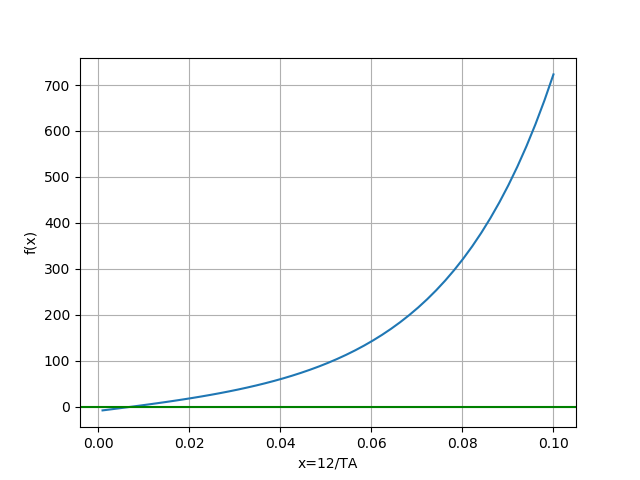Ejercicio: 1Eva_IT2019_T2 Catenaria cable
Las fórmulas con las que se requiere trabajar son:
y = \frac{T_A}{w} cosh \Big( \frac{w}{T_A}x \Big) + y_0 - \frac{T_A}{w}Donde la altura y del cable está en función de la distancia x.
Además se tiene que:
cosh(z) = \frac{e^z+ e^{-z}}{2}que sustituyendo la segunda en la primera se convierte en:
y = \frac{T_A}{w} \frac{e^{\frac{w}{T_A}x}+ e^{-\frac{w}{T_A}x}}{2} + y_0 - \frac{T_A}{w}y usando los valores del enunciado w=12, y0=6 , y=15, x=50 se convierte en:
15 = \frac{T_A}{12} \frac{e^{\frac{12}{T_A}50}+ e^{-\frac{12}{T_A}50}}{2} + 6 - \frac{T_A}{12}simplificando, para usar el método de búsqueda de raíces:
\frac{1}{2}\frac{T_A}{12} e^{\frac{12}{T_A}50} + \frac{1}{2}\frac{T_A}{12} e^{-\frac{12}{T_A}50} - \frac{T_A}{12} - 9 = 0cambiando la variable \frac{12}{T_A}=x
\frac{1}{2x} e^{50x} + \frac{1}{2x} e^{-50x} - \frac{1}{x}-9=0la función a usar para la búsqueda de raíces es:
f(x)=\frac{1}{2x} e^{50x} + \frac{1}{2x} e^{-50x} - \frac{1}{x}-9Para el método de Newton-Raphson se tiene que:
x_{i+1} = x_i -\frac{f(x_i)}{f'(x_i)}por lo que se determina:
f'(x)= - \frac{1}{2x^2}e^{50x} + \frac{1}{2x}(50) e^{50x} + - \frac{1}{2x^2} e^{-50x} + \frac{1}{2x}(-50)e^{-50x} + \frac{1}{x^2} f'(x)= -\frac{1}{2x^2}[e^{50x}+e^{-50x}] + + \frac{25}{x}[e^{50x}-e^{-50x}] +\frac{1}{x^2} f'(x)= \Big[\frac{25}{x} -\frac{1}{2x^2}\Big]\Big[e^{50x}+e^{-50x}\Big] +\frac{1}{x^2}Con lo que se puede inicar las iteraciones.
Por no disponer de valor inicial para TA, considere que el cable colgado no debería tener tensión TA=0 N, pues en la forma x=12/TA se crea una indeterminación. Si no dispone de algún criterio para seleccionar el valor de TA puede iniciar un valor positivo, por ejemplo 120 con lo que el valor de x0=12/120=0.1
Iteración 1
f(0.1)=\frac{1}{2(0.1)} e^{50(0.1)} + \frac{1}{2(0.1)} e^{-50(0.1)} - \frac{1}{0.1}-9 =723.0994 f'(0.1)=\Big[\frac{25}{0.1} - \frac{1}{2(0.1)^2}\Big]\Big[e^{50(0.1)}+e^{-50(0.1)}\Big] + +\frac{1}{(0.1)^2} = 29780.61043 x_{1} = 0.1 -\frac{723.0994}{29780.61043} = 0.07571error = | x1 - x0| = | 0.07571 - 0.1| = 0.02428
Iteración 2
f(0.07571)=\frac{1}{2(0.07571)} e^{50(0.07571)}+ + \frac{1}{2(0.07571)} e^{-50(0.07571)} - \frac{1}{0.07571}-9 = 269.0042 f'(0.07571)= \Big[\frac{25}{0.07571} -\frac{1}{2(0.07571)^2}\Big]. .\Big[e^{50(0.07571)}+e^{-50(0.07571)}\Big] + +\frac{1}{(0.07571)^2} = 10874.0462 x_{2} = 0.07571 -\frac{269.0042}{10874.0462} = 0.05098error = | x2 - x1| = |0.05098- 0.02428| = 0.02473
Iteración 3
f(0.05098) = 97.6345 f'(0.05098) = 4144.1544 x_{3} = 0.0274error = | x3 - x2| = |0.05098- 0.0274| = 0.0236
finalmente después de varias iteraciones, la raiz se encuentra en: 0.007124346154337298
que convitiendo
T_A = \frac{12}{x} = \frac{12}{0.0071243461} = 1684.36 NRevisión de resultados
Usando como base los algoritmos desarrollados en clase:
['xi', 'xnuevo', 'tramo'] [0.1 0.0757 0.0243] [0.0757 0.051 0.0247] [0.051 0.0274 0.0236] [0.0274 0.0111 0.0163] [0.0111 0.0072 0.0039] [7.2176e-03 7.1244e-03 9.3199e-05] [7.1244e-03 7.1243e-03 3.8351e-08] raiz en: 0.007124346154337298 TA = 12/x = 1684.365096815854
Algoritmos Python usando el procedimiento de:
https://blog.espol.edu.ec/analisisnumerico/2-3-1-newton-raphson-ejemplo01/
# 1Eva_IT2019_T2 Catenaria cable import numpy as np import matplotlib.pyplot as plt # INGRESO a = 0.001 b = 0.1 muestras = 51 x0 = 0.1 tolera = 0.00001 fx = lambda x: 0.5*(1/x)*np.exp(50*x) + 0.5*(1/x)*np.exp(-50*x)-1/x -9 dfx = lambda x: -0.5*(1/(x**2))*(np.exp(50*x)+np.exp(-50*x)) + (25/x)*(np.exp(50*x)-np.exp(-50*x)) + 1/(x**2) # PROCEDIMIENTO tabla = [] tramo = abs(2*tolera) xi = x0 while (tramo>=tolera): xnuevo = xi - fx(xi)/dfx(xi) tramo = abs(xnuevo-xi) tabla.append([xi,xnuevo,tramo]) xi = xnuevo tabla = np.array(tabla) n=len(tabla) TA = 12/xnuevo # para la gráfica xp = np.linspace(a,b,muestras) fp = fx(xp) # SALIDA print(['xi', 'xnuevo', 'tramo']) np.set_printoptions(precision = 4) for i in range(0,n,1): print(tabla[i]) print('raiz en: ', xi) print('TA = 12/x = ', TA) # Grafica plt.plot(xp,fp) plt.xlabel('x=12/TA') plt.ylabel('f(x)') plt.axhline(0, color = 'green') plt.grid() plt.show()
